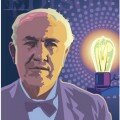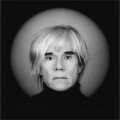The Magic of Creation…
We keep moving forward, opening new doors, and doing new things, because we’re curious and curiosity keeps leading us down new paths
- Walt Disney
Just like the word ‘success’, ‘create’ means something different to everyone.
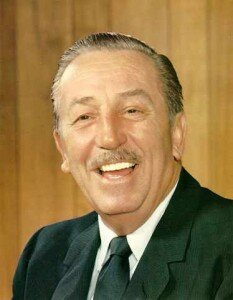
In my mind, creating is bringing colour and new knowledge to a life outside of our own, in a way that’s just that little bit better than how it was brought to you originally. Inspired by past characters, and inspiring future characters if you like. In your mind it may stand for something slightly different. But we can all agree on one thing; that the world would be a very dull and unchanging place without the ability (or hunger) to create.
Walt Disney, is one of my favourite examples of ‘creators’. Because Walt Disney stands strong, not just as a philanthropist of movies, but as a recognised hero to all worlds of people; children and adults alike. Almost every child knows Mickey Mouse. Almost every child has watched a Disney movie and smiled and laughed and learned from what they see, their lives touched by Walt Disney’s fingertips, and a better place because of it.
Disney continues to win the hearts of children globally as a result of his unique, revolutionary and creative works even forty-seven years after his death. His dream was to make life more enjoyable and to discover a new way to tell and to teach. He dedicated his own life to pioneer the field of animation and fulfil this cause. As a result Walt Disney is remembered, idolised and forever living on in the memories and hearts of the minds he captured.
This is all about how you can learn from the life he lead.
Walt Disney Bio: The History that made the legend…
If you can dream it, you can do it – Walt Disney
Walt Disney was born in 1901 to Elias and Preacher Walter Parr in Chicago, Illinois, USA. The family was a large one -with Walt being the fourth brother- and often struggled with financial difficulties. Aged four, Walt’s neighbour encouraged and sometimes even paid the young artist for his drawings he made of the animals on the farm where his family lived. This farm became the seeds for Disney’s growing love of nature and animals. The retired Doctor was the first person to encourage the interests of young Walt.
Throughout Walt’s childhood, the Disney family moved from Merceline to Missouri to Kansas City. The childhood years of Disney were vital in his creation because they inspired his mission for life later on; to bring a less humdrum happiness to the children across the world. Although Walt insisted his works were not aimed at children, they captured the hearts of them. Something great for him as he believed that the minds of children was the ‘greatest national resource’.
 From an early age, Walt loved to draw, particularly trains and animals. His creativity was spotted stood out from all those around him, which developed into a skill as he grew older. This passion often made Disney stand out from the crowd and in class he was often found drawing cartoon characters instead of doing his schoolwork.
From an early age, Walt loved to draw, particularly trains and animals. His creativity was spotted stood out from all those around him, which developed into a skill as he grew older. This passion often made Disney stand out from the crowd and in class he was often found drawing cartoon characters instead of doing his schoolwork.
In 1917, at eighteen years of age, Walt graduated from Benton High School in Kansas. During this time he spent his Saturdays learning at the Kansas City Art Institute and discovered his first movie house on Marceline’s Main Street. In terms of movies, it was love at first sight. But his life in the country continued to fuel his love for nature.
In 1917 the family moved to Chicago. As if this wasn’t a challenge enough, Walt’s father was a strict man and the family grew more and more financially constrained. But Walt Disney did not let either shake up or ruin his focus and began drawing for the school newspaper and attending night classes at the Chicago Art Institute. He was determined to draw, to get better and to share his works. As a result his talent for artistic drawing flourished.
His mother and brother Roy encouraged his gift. His father did not.
But approval did not matter to Walt. Against his father’s permission Walt would sneak out of the house to perform comedy at local theatres. People loved to listen to Walt. Even in ordinary conversation it was clear he had the rare ability to tell any story and captivate an audience. And as long as the people were prepared to listen, Walt was prepared to do anything to share.
He spent his teenage years drawing, acting and performing. In school, even, he entertained his friends with Chaplin impressions and storytelling; which he illustrated on the black board in lesson time.
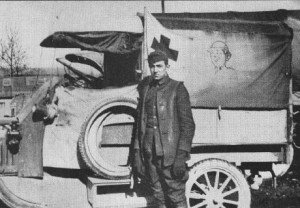 In the years that followed, however, his focuses lay with working as a member of the American Ambulance Corps in France. Walter lied about his age to be accepted and dropped out of school. The ambulance he drove around Europe was covered with drawings of cartoon characters instead of camouflage. Attempting to bring some joy to the people, in a concrete world. Even today, Walt Disney’s morality is honoured and any U.S Military member has free admission into Disney parks.
In the years that followed, however, his focuses lay with working as a member of the American Ambulance Corps in France. Walter lied about his age to be accepted and dropped out of school. The ambulance he drove around Europe was covered with drawings of cartoon characters instead of camouflage. Attempting to bring some joy to the people, in a concrete world. Even today, Walt Disney’s morality is honoured and any U.S Military member has free admission into Disney parks.
A few years later, Walt returned to the US, started his career in commercial art . He began experimenting with animation for the first time and got a job in an art studio producing short animated films. It was underpaid, at around $50 a month, and Walt ran out of money quickly.
Things got worse, before they got better.
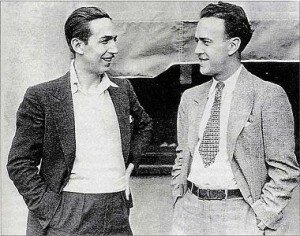 In the years that followed, Walt worked with Ub Lwerks (a close friend of Walt’s) to form a small artist group and work for a slide company. But The Alice Comedies and his company Laugh-O-Grams went bankrupt fast. The risk he was taking in being an artist began to seem all that more like a risk than a passion.
In the years that followed, Walt worked with Ub Lwerks (a close friend of Walt’s) to form a small artist group and work for a slide company. But The Alice Comedies and his company Laugh-O-Grams went bankrupt fast. The risk he was taking in being an artist began to seem all that more like a risk than a passion.
“It’s no secret that we were sticking just about every nickel we had on the chance that people would really be interested in something totally new and unique in the field of entertainment.”
But he did not give up, proving that sometimes a risk is worth taking. At the tender age of twenty-two Walt went to Hollywood to start again. He joined both resources and forces with his brother Roy and set up shop in their Uncle’s garage. This was the first physical step towards Walt’s success, showing both the importance of collaboration and risk-taking when reaching for success.
The first order for Alice meant that the brothers could expand their production to the rear of a Hollywood real estate office. His wife, Lillian Bounds, whom he married in 1925, was one of his first Employees. They had two children, Diane and Sharon.
But neither Disney’s family life nor passion for art suffered. Three years after they wed, Walt created the legendary Mickey Mouse. A character whom, to this day, continues to form a sort of symbol for fun and childhood. And whilst the success of Hollywood climbing continued, Walt stayed at home most evenings to eat with his family and never missed the chance to be a become a better father.
Daddy never missed a father’s function no matter how I discounted it. I’d say, “Oh, Daddy, you don’t need to come. It’s just some stupid thing.” But he’d always be there, on time.
Just goes to show, that you can have it all.
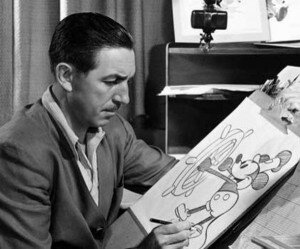 Just before the release of ‘Plane Crazy‘, a silent cartoon, sound was introduced to the world of movies and, ever up to date, Disney ensured Mickey Mouse made his debut in 1928 New York as the first synchronised sound cartoon. This was the first step to the perfect art animation. And an important lesson to learn in terms of keeping your roots, a passion. But still ensuring that it suits your audience and makes the most of your time.
Just before the release of ‘Plane Crazy‘, a silent cartoon, sound was introduced to the world of movies and, ever up to date, Disney ensured Mickey Mouse made his debut in 1928 New York as the first synchronised sound cartoon. This was the first step to the perfect art animation. And an important lesson to learn in terms of keeping your roots, a passion. But still ensuring that it suits your audience and makes the most of your time.
Technicolor was introduced. And after its arrival Walt made only colour cartoons; refusing to create anything but perfection. Walt’s first full-length movie, Snow White and the Seven Dwarfs, was the first full-length animated musical feature. The film cost $1,499,000 to make, which was unthinkable in the time of the depression. The fact that we still watch this film today, however, shows us the quality of the movies Walt produced.
But again, disaster occurred. In 1938, after the films great success, Walt and Roy used the money they made to bring their parents to a home nearby. Just a month later their mother died of asphyxiation, caused by a furnace in their family home. It is believed that Walt blamed himself for his and suffered with depression for a long time continuing.
But although Walt was grieving, he kept building his kingdom. Animation became a second nature. Classics such as Pinocchio, Dumbo, Bambi, were brought to screens, themselves bringing joy in hard times. Disney grew. His staff spread to 1,000 and his studio’s construction was finally complete. He was ready to take the world by storm.
During the war, much of the facilities were used for propaganda. But Walt produced multiple short sketches to help boost civilian and military moral.
In his time more than 100 features were produced by the studio, helping to teach children in the way that he saw right; through fuelling the imagination. His features were nearly all award-winning, unique and popular. But of course, Walt didn’t stop there.
He wanted not only to provide for the world, but to provide a world. A world that thought like him, that fuelled the mind. So in 1955, the first Disneyland Park was opened, a kingdom that has entertained more than 200 million people globally.
As TV blossomed and bloomed so did his work. He produced one of the first colour programs The Mickey Mouse Club in the 1950’s and a plan called EPCOT which ensured the creation of a living showcase for the creativity of American industry.
To fulfil this he brought land in Florida and spent seven years planning this new Disney world with a theme part, hotel, It was opened in 1982, the same year as the EPCOT centre. In 1989 as Disney-MGM Studios Theme Park shortly followed.
As you can see Walt was a success because he was forever creating. Forever fulfilling. Forever making the world a better place. And forever moving with the times. Enough was never enough and so Disney died not a man. Not an amazing entrepreneur, successful director, chief animator, and not even as one of the best movie producers in the world. But he died a legend.
Leaving behind his own magical story of downfalls, motivation and all that spins from his self-made success in the world of movie magic and the minds of all people watching.
Disney Lessons
Inspiring the Future: How To Create Well
Move with the times…
He didn’t give technology to us piece by piece, he connected it to his on-going mission of making life more enjoyable, and fun.
Walt Disney wasn’t born knowing how to take the world by storm with his creations. Disney was inspired by the creators before him, inspired by the now and as a result became an inspiration himself for entertainment as we know today.
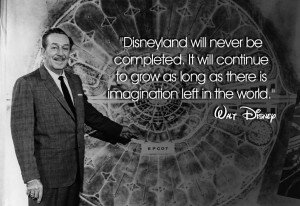 Part of being a creator of any sort is seeing the whole picture in your vision. To do this you must think about what people did in the past that you admire, and how you can make the world better using what you have that they didn’t. Movie producers before Disney didn’t have sound or colour in their cartoons, or the ability to make TV shows. Disney pinpointed these developments available to him and ensured he was the first to use them.
Part of being a creator of any sort is seeing the whole picture in your vision. To do this you must think about what people did in the past that you admire, and how you can make the world better using what you have that they didn’t. Movie producers before Disney didn’t have sound or colour in their cartoons, or the ability to make TV shows. Disney pinpointed these developments available to him and ensured he was the first to use them.
The cycle of creation is forever continuing as a result of the shared persistence for the future and the discovery of new ways to bring joy to life that all creators share. Now producers, who were just like Disney, are creating 3D and high definition cartoons. Forever keeping the snowball rolling and growing to suit the audience who are also rolling and growing.
We have the fortune today of having technology at our fingertips. We can self-publish books on e-devices. Make websites on the meaning of life in a few clicks. Create films on our phones. But we can also get engulfed by other people’s creations too. What I’m asking you to do now, is think like Walt. Think of the opportunities of here and now. And how you can use them for you here and now.
But remember, there is always survival of the fittest in the chain of self-success. Technology is also at the fingertips of someone who’s just slightly better.
Think outside the box & not just when your creating…
Crowded classrooms and half-day sessions are a tragic waste of our — the minds of our children.
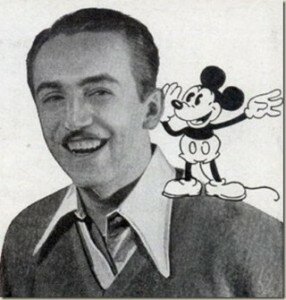 There is a difference between education and schooling. The schooling we are given, in terms of qualifications, is important don‘t get me wrong. You have to keep the fundamentals strong, so you have support to get you to where you want to be. And schooling builds our brains to take on new information and brings us opportunities to step closer to fulfilling whatever we were born to fulfil. For example, if you want to be an artist, you have to do well in art at school to get into art class.
There is a difference between education and schooling. The schooling we are given, in terms of qualifications, is important don‘t get me wrong. You have to keep the fundamentals strong, so you have support to get you to where you want to be. And schooling builds our brains to take on new information and brings us opportunities to step closer to fulfilling whatever we were born to fulfil. For example, if you want to be an artist, you have to do well in art at school to get into art class.
But where schooling downfalls, is in its emphasis. We are forever bombarded with its importance. With homework. With requirements. Because it fits us into a pigeon hole and gives us a concrete purpose, if you like, to benefit the people who control it.
But because the curriculum is universal, the information you are given in school, is also universal. It’s given to everyone else. The opportunities are shared (and therefore fort for) by everyone else. The step closer just brings you in line with everyone else. And, by coming on this website I know that you don’t want to be like everyone else. If you want to create, you have to make a hole. To provide different, you have to be different. And unfortunately schools usually don’t have the time to consider differences. And thus the young and budding artists, writers, singers, and dancers are forced into a world that everybody knows.
You’re on your own buddy.
But don’t fear. Do a Disney and take all this, the information, the opportunities, the step in your own way, to your own advantage. Take all this and warp it to your heart content.
But remember to put your main energies into learning and developing your individual strengths as you go about strengthening that back bone.
Walt Disney dropped out of school. But during school he entertained, took outside art classes and looked and listened to the world around him, the farm for example. The lesson to be learnt here is never stop looking for ways that you can further yourself as a person. Walt is not remembered as the person who dropped out of high school, but for being a creator, and for the things he created.
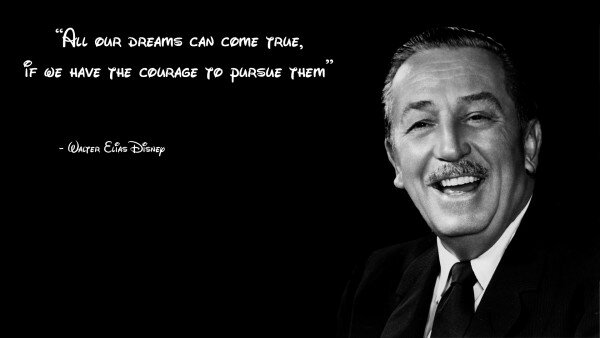 Nobody will come up to you and teach you how to write a book or draw cartoons. Walt’s Dad, in fact, tried to stop him. If there are none, create your own opportunities. Create outside of your physical work. Create your own life and there will be no boundaries. Because it doesn’t matter if you don’t have a GCSE to your name, if you have a talent or passion, you’ll to find a way to be successful.
Nobody will come up to you and teach you how to write a book or draw cartoons. Walt’s Dad, in fact, tried to stop him. If there are none, create your own opportunities. Create outside of your physical work. Create your own life and there will be no boundaries. Because it doesn’t matter if you don’t have a GCSE to your name, if you have a talent or passion, you’ll to find a way to be successful.
Quality then Quantity…
The more you like yourself, the less you are like anyone else, which makes you unique.
In order to be labelled ‘successful’ you have to have had multiple successes. But to have a single success, you have to have something good to offer. So never rush your work and ensure that you are always learning from other people. But also remember to make your own choices.
 Walt’s dad didn’t approve of his son’s entertainment dreams. But the theatres he snuck out to educated him in a way that no other opportunity would. And he learned about people, what made them smile, laugh and cry, before he provided for them. If someone doesn’t like your work, understand why but make your own judgement. And vice versa, if someone likes your work but you know you can do better go back to your desk.
Walt’s dad didn’t approve of his son’s entertainment dreams. But the theatres he snuck out to educated him in a way that no other opportunity would. And he learned about people, what made them smile, laugh and cry, before he provided for them. If someone doesn’t like your work, understand why but make your own judgement. And vice versa, if someone likes your work but you know you can do better go back to your desk.
You’ll be making magic in no time.

